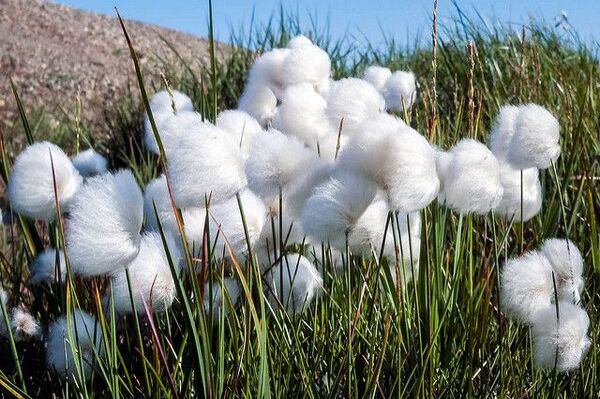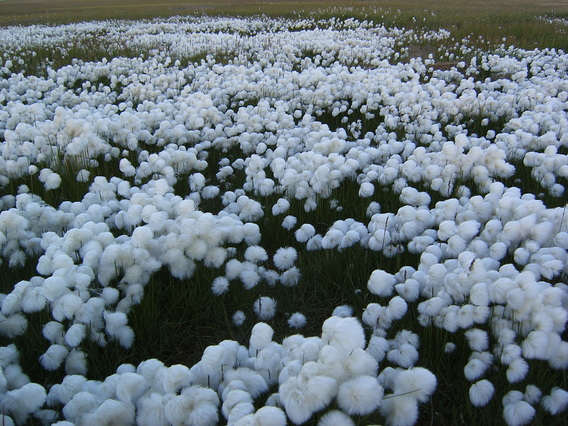If you’ve ever wandered through wetlands, marshes, or moorlands, you may have noticed fluffy, cotton-like plants swaying in the breeze. These charming plants are called Eriophorum, commonly known as Cotton Grass. Despite their delicate, cloud-like appearance, Eriophorum is a tough plant that thrives in the most challenging environments, including wet, boggy areas and cold, high-altitude regions.
In this article, we’ll explore the fascinating world of Eriophorum, including its appearance, unique growing conditions, ecological importance, and tips on how to grow this magical plant in your own garden.

Eriophorum, also known as Cotton Grass, belongs to the Cyperaceae family, which includes sedges and other wetland plants. This plant is recognized for its distinctive, fluffy flower heads that resemble cotton balls or tufts of wool. The name "Cotton Grass" comes from its soft, white, and feathery inflorescences, which appear like fluffy clouds drifting above the grassy stems.
The flowers of Eriophorum are small but grouped together in large clusters, forming a soft, white or pale yellow ball at the top of long, slender stems. When in full bloom, these flower clusters look almost like cotton candy or snowflakes, creating a beautiful contrast against the green wetland backdrop.
Eriophorum is native to wetlands, bogs, and marshy areas found in cold and temperate regions of the Northern Hemisphere, including North America, Europe, and Asia. It is particularly common in high-altitude regions, where it can be found growing in cool, humid conditions. This hardy plant thrives in areas with poorly drained, acidic soil and can often be spotted in areas where other plants might struggle to survive.
In these wetland ecosystems, Eriophorum plays an important role in stabilizing soil and maintaining the delicate balance of these environments. The plant has adapted to grow in waterlogged soils, which are rich in organic material but low in oxygen, making it ideal for wetland habitats.
Beyond its visual appeal, Eriophorum is a vital component of wetland ecosystems. It plays several key ecological roles:
Soil Stabilization: The plant’s dense root system helps prevent erosion and stabilizes the soil in wetlands. This is especially important in areas where the soil is saturated with water and prone to shifting.
Water Filtration: Cotton Grass contributes to the filtration of water, as its roots help trap sediment and pollutants. This makes wetlands with Eriophorum healthier, cleaner, and more balanced ecosystems.
Wildlife Habitat: Eriophorum provides valuable habitat for various wetland animals, such as birds, insects, and small mammals. Its dense clumps offer shelter and food sources for these creatures.
Carbon Sequestration: Wetlands, including those where Eriophorum grows, are important carbon sinks. They absorb carbon dioxide from the atmosphere, helping mitigate climate change by storing carbon in the form of organic matter in the soil.

If you want to add Eriophorum to your garden, it’s important to replicate its natural environment to ensure the plant thrives. Here are some tips for successfully growing Cotton Grass in your garden:
Soil: Eriophorum prefers acidic, waterlogged soil that is rich in organic matter. To create a suitable growing medium, you can amend your soil with peat moss or acidic compost. It’s essential that the soil remains moist but not waterlogged.
Light: This plant grows best in full sun to partial shade. It can tolerate some light shade, especially if it is planted in a wet, boggy area that mimics its native habitat.
Water: Cotton Grass loves water. It thrives in wet conditions, so ensure that the soil remains consistently damp throughout the growing season. If you’re growing it in a dry climate, you may need to water it more frequently to keep the soil moist.
Temperature: Eriophorum is well-suited to cooler climates. It can withstand cold temperatures, making it a great choice for gardens in temperate and northern regions. If you live in a warmer area, it’s best to plant Cotton Grass in a location that is sheltered from the heat, such as near a pond or a water feature.
Spacing: Cotton Grass tends to spread through rhizomes and can form dense clumps. Space plants about 12-18 inches apart to allow for this natural spreading habit.
Pruning: While Eriophorum requires little maintenance, it’s a good idea to remove dead or damaged foliage during the winter to promote new growth in the spring.
The most striking feature of Eriophorum is its flower heads. These fluffy, white inflorescences resemble clouds or cotton balls, creating a soft, ethereal appearance. When wind blows through a stand of Cotton Grass, the flower heads sway gently, adding a magical quality to the landscape.
In late summer and fall, these feathery flowers start to mature and spread their seeds through wind dispersion. The cotton-like fluff acts as a natural seed carrier, helping the plant to propagate and spread across the wetland areas where it thrives. The sight of Eriophorum in bloom can be truly mesmerizing, transforming wetlands into fields of soft, white “cotton.”
Unique Aesthetic: The striking appearance of the cotton-like flower heads makes Eriophorum a standout feature in any garden. Whether planted in a pond, wetland garden, or alongside other wildflowers, this plant adds a soft, airy quality to the landscape.
Easy to Care For: Once established, Eriophorum requires minimal care. It thrives in wet, boggy areas, and its natural resilience makes it a great choice for gardeners looking to add a low-maintenance yet beautiful plant to their garden.
Support for Wetland Ecosystems: Growing Eriophorum in your garden not only adds beauty but also supports local wildlife and helps create a more eco-friendly environment.
Eriophorum (Cotton Grass) is more than just a beautiful plant. It plays a crucial role in wetland ecosystems, offering soil stabilization, water filtration, and habitat for wildlife. With its stunning, fluffy flower heads and its ability to thrive in wet, boggy areas, Cotton Grass is the perfect addition to any garden looking to capture the magic of wetlands. If you have the right conditions, growing Eriophorum will not only enhance the beauty of your garden but also contribute to a healthier, more sustainable environment.
animal tags: Eriophorum Cotton-Grass
We created this article in conjunction with AI technology, then made sure it was fact-checked and edited by a Animals Top editor.